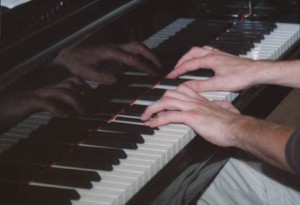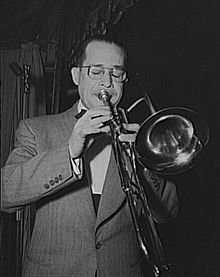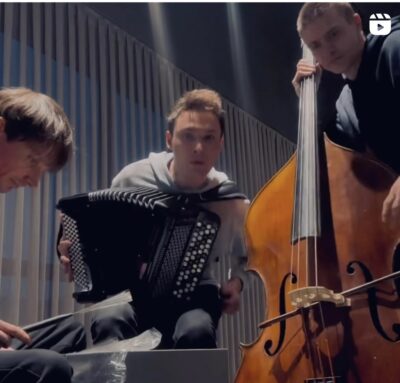Because Joseph Haydn died in 1809, there have been many celebrations of his music this year. Even Cottonopolis held a mini-fest of his symphonies earlier in the summer. For a very long time, I did not enjoy Haydn’s symphonies, hearing them as light-weight, shallow and frivolous. The musical jokes were mildly amusing the first time you hear them, but are not amusing after repeated exposure. Rather, in marked contrast to his sacred music, Haydn’s symphonic music struck me most forcefully as twee. Perhaps there was something in the social circumstances of their commissioning or their performance that precluded the intense and the profound being expressed in his symphonies. El Papa’s symphonies have a flippancy one can also hear in lots of Mozart (excepting inter alia his last four Symphonies), in Beethoven (when he’s not being self-consciously serious), and stretching, in what seems to me became a peculiarly-Viennese tradition, all the way to the waltzing Strauss family and even to Mahler. With the Strausses, it is all foam, all the time. This Viennese flippancy virus even infected composers far away, such as Mahler’s great admirer, Shostakovich, whose Concerto for Piano and Trumpet (for example) is one long musical joke. Perhaps only in a city surrounding an imperial court could music so frivolous, so lacking in gravitas, be desired, written or admired.
However, by chance a few years ago, I heard one of Haydn’s so-called Sturm-und-Drang (Storm and Stress) Symphonies. Here at last was the serious Hadyn I knew from the oratorios and the chamber music, writing music which expressed deeply-felt emotions, and which evoked them, and did both intensely. These symphonies from his middle period, written between 1768 and 1772 when he was in his late 30s, and usually counted as numbers 44-49, are more powerful and intense than his other symphonies, in my opinion. In comparison to the music of the practical jokester, they are strange and difficult. They were clearly written by someone experiencing some emotional torment, and they make for uncomfortable listening.
Recently, I heard a radio broadcast of a symphony which at first I thought was another Haydn sturm-und-drang work, but which I did not know. It turned out to be a work by one of Haydn’s contemporaries, Johann Baptist Vanhal (1739-1813), a Czech composer who lived mostly in Vienna from 1760. I have since listened to all his works I can find recorded. Here is music to be reckoned with – deeply intense, emotional, profound, technically sophisticated, and much better than Haydn’s best symphonies. Technically, Vanhal strikes me as more adept than Haydn, innovative in his choice of instrumentation, and approaching the level of Beethoven in his manipulation and development of musical ideas to achieve profound and moving effects. The thrilling opening of Symphony bryan c2 (the second in c minor in the numbering system of Paul Bryan) is surely one of the most exciting of the whole 18th century, sending the hairs on my neck straight up. And the theme is then developed to a place of intense sadness and feeling. The final movement of this symphony is also quite thrilling, with fast, high string figures repeated while the harmonies beneath them move. Similarly, Vanhal uses a moving bass line to add a profound edge to a somewhat frivolous melody line in the third movement (Allegro) of Symphony bryan D4 (the fourth in D major). The fourth movement of Symphony bryan d1 is also intense and thrilling.
In the 4th movement of Symphony bryan g2, Vanhal uses a development idea which is often found in Bach – a figure is played three times, descending a tone each time, over six elements of a circle-of-fifths harmonic progression (eg, E – A, D – G, C – F). (To be fair, Haydn also uses similar gadgets – for example, the thrilling circle-of-fourths progression in the development section of the first movement of his Symphony #48 in C, Maria Theresa.) Supposedly one of the pleasures we gain from listening to music comes from anticipation – our brains are continually predicting what will come next, and when it does we gain enjoyment – and hearing this figure always provides me with great pleasure. In the intensity of his music and in the development sections, we hear also a prefigurement of Gossec and Beethoven and later symphonic composers.
Why do we not hear more of Vanhal’s music? Why are all his symphonies not yet recorded? Especially in this year of Hadynolatry we should be hearing the music of his contempories and those who influenced him – Vanhal, von Dittersdorf, Michael Haydn – or vice versa, especially when they wrote better music and music which clearly influenced later composers. If the BBC took seriously its mission to educate as well as to entertain, we could perhaps expect better. Instead, we get to hear once again Haydn’s musical jokes, as if these were new to us, or funny.
References:
Josef Haydn: “Sturm und Drang” Symphonies, nos. 44-49. Symphony Orchestra of Radio Zagreb, Antonio Ianigro (conductor). Artemis Classics, 2004.
Johann Vanhal: Symphonies. London Mozart Players, Matthias Bamert (conductor). Chandos Records, 1998. Contains Symphonies Bryan g2, D4 and c2.
Johann Vanhal: Symphonies. Concerto Koln (no conductor listed). Elatus, 1996. Contains Symphonies Bryan d1, g1, C11, a2 and e1.
Johann Vanhal: Symphonies Volume 1. Nicolaus Esterhazy Sinfonia, Uwe Grodd (conductor). Naxos, 1999. Contains Symphonies Bryan A9, C3, D17, and C11.
Johann Vanhal: Symphonies Volume 2. City of London Sinfonia, Andrew Watkinson (conductor). Naxos, 2000. Contains Symphonies Bryan Bb3, d2, and G11.
Johann Vanhal: Symphonies Volume 3. Toronto Camerata, Kevin Mallon (conductor). Naxos, 2005. Contains Symphonies Bryan D2, Ab1, c2, and G6.
Johann Vanhal: Symphonies Volume 4. Toronto Chamber Orchestra, Kevin Mallon (conductor). Naxos, 2008. Contains Symphonies Bryan e3, C17, C1, and Eb1.



